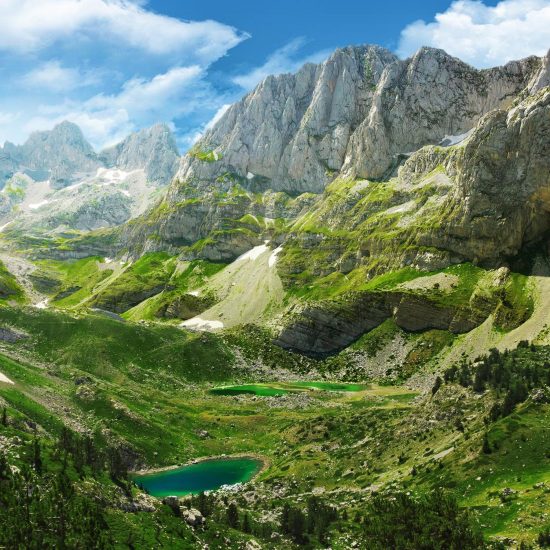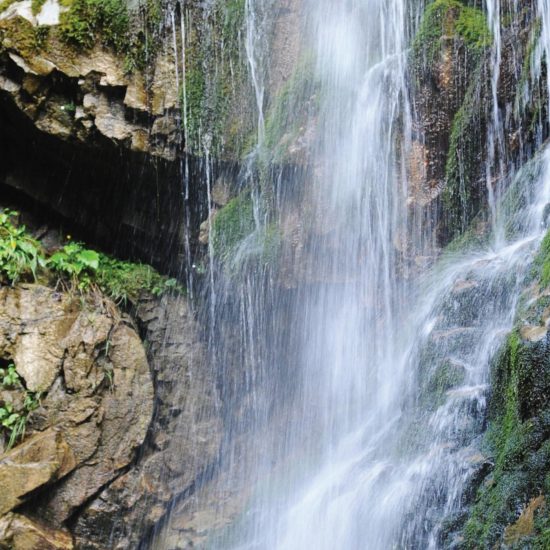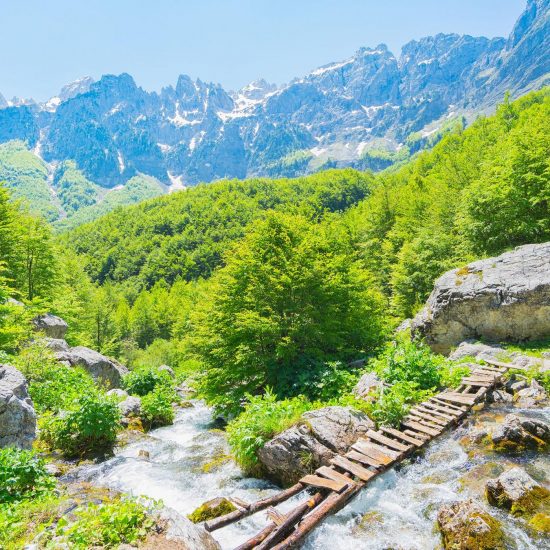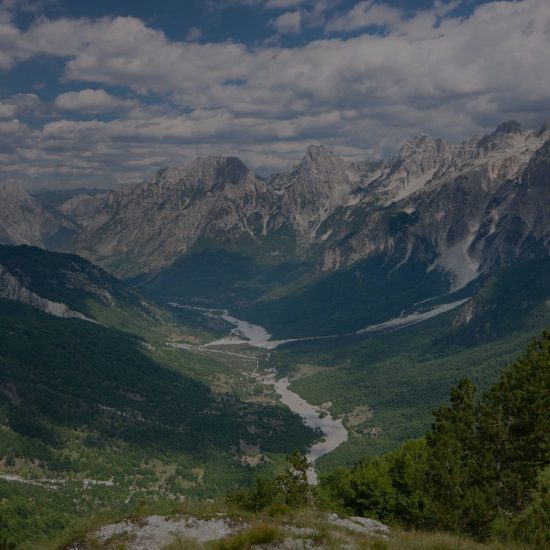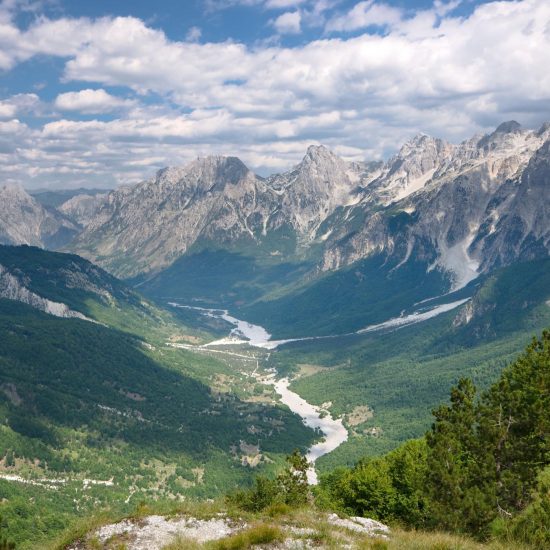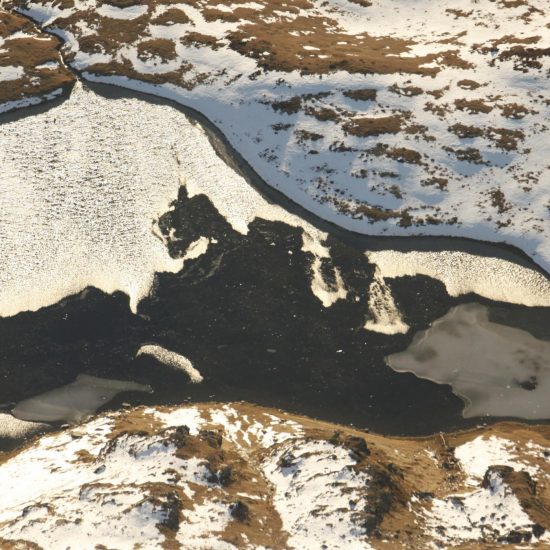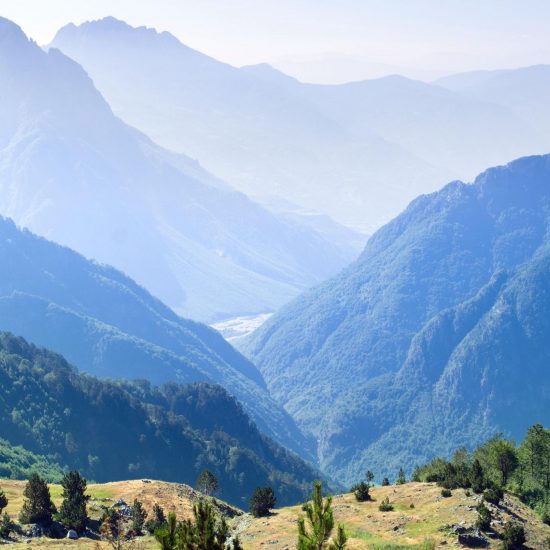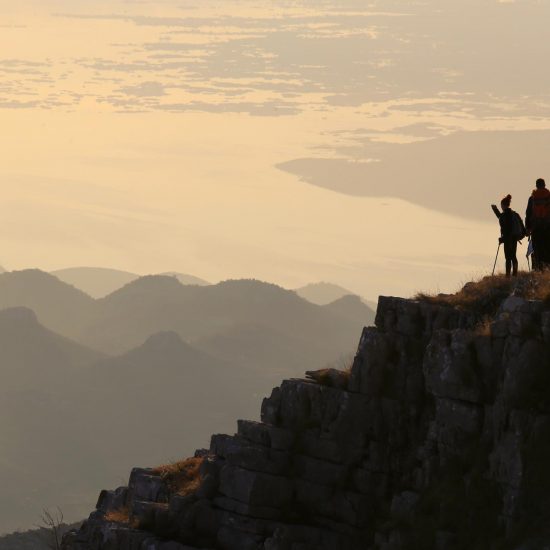Vermoshi
Another interesting spot of the Western Alps is Vermosh, located in the northern-most mountains of Albania, 95 km from Shkodra in the region of Kelmend (from the Roman word “Clemens,” meaning gentle, simple, and good). The first thing that catches your eye along the journey is Qafa e Rrapshit, where you can see the crystal-clear waters of the Cemi River creating a beautiful contrast with the surrounding landscape. During summer, the ponds of the river are perfect for sunbathing and many visitors stop to lounge in the sun and enjoy themselves. Vermosh stands in an alpine field 1,100 m above sea level surrounded by high slopes. You can entertain yourself by trekking, mountain climbing, skiing, or fishing for mountain trout. The locals pride themselves that their cuisine is only truly enjoyable for visitors when accompanied by their own dairy products, so be sure to indulge. A real journey among the people of this region will give you not only the chance to experience a world located between traditional village life and contemporary society, but will also let you enjoy the hospitality renowned by almost every visitor who has been fortunate enough to visit.
Thethi
Located 70 km from Shkodra, you must pass Qafa e Tërthores at 2,000 m before descending to Gropa e Thethit by crossing a stream bearing the same name. It is a journey you’ll want to have your camera ready for, full of extended mountain views, with water cascading down craggy hillsides and trees reaching for sunlight on rocky slopes. The area is rich in sights such as the waterfall of Grunas, 30 m high, the amazing cold-water sources of Okol, and the caves of Birrat me Rrathë (Round Holes) and Mount Arapi. In the park people often amuse themselves by hiking, mountain climbing, skiing (especially on the eastern slope), fishing, even mountain biking and spelunking. Almost 90% of the park area is covered by beech trees, providing shade for many different types of flowers such as the Wulfenia baldacci, discovered by the Italian botanist Baldacci. Fascinatingly, this flower is found only in Theth. The fauna is just as rich as the flora, distinguished by the famed golden eagle and rreqebull (lynx). In the waters of Theth’s stream, marble trout make their home. While in Theth you can stay in local guesthouses designed to display traditional alpine architecture. The characteristic dish of the area is fërlik (rotisserie) or you can sample one of large varieties of local trout. If time permits, many travelers enjoy a short excursion to the Shala Valley which brings them close to the heart of the Albanian Alps.
Valley of Valbona
The Valbona River valley lies in the eastern part of the Albanian Alps. A national park of 8,000 hectares, it is one of the most beautiful natural areas in Albania. The park lies about 22 km from the alpine city of Bajram Curri. Before entering the valley you will find the spring (vrellen) of Shoshan, located only 3 km away from Bajram Curri. This spring rushes through limestone fissures on its way to the Valbona River creating an attractive canyon, 2-3 m wide and 50 m deep. After entering the valley, you will pass several picturesque villages. The first, with alpine style houses, is called Dragobia, and it is where the valley narrows. Past Dragobia, at the foot of the mountain where the Cerremi stream joins the Valbona River, is the famous cave where the national hero Bajram Curri was besieged and killed. It was after this event that the city took his name. Valbona is located 25 km away from the city of Bajram Curri and is the most important inhabited center of the valley. It is full of traditional houses that create a picturesque view in symmetry with the natural wonders of the valley, which widens again at this point. In Valbona there is a comfortable and traditional hotel, or you may have the opportunity to stay at a village home, as the inhabitants’ generosity and hospitality are well known. The area is also known for its characteristic regional cooking, with specialties such as mazja, flija (a many layered pancake-like dish cooked outdoors over open coals and steamed, often served with local honey), and pitja. Beyond Selimaj, the road continues through the valley with breathtaking vistas with rich colors of both spring life and of the snow that covers the nearby craggy peaks. The final village before you arrive at the source of the Valbona River is Rrogam. Rrogam is a remote village surrounded by virgin natural landscapes. The entire valley is resplendent with rare colors and beauty. On one side, you see the crystal-clear waters of Valbona, and on the other sharp but verdant mountain face. Until May you can enjoy the contrast of the clean white snow on the treetops against the blue sky. The flora of the national park includes a variety of plants and trees, the most widespread of which are the silver fir tree. The rest consists of beech woods, walnuts, chestnuts, and wild apple. There are also numerous berries, including wild blueberries and strawberries. The animals in the park include bears, wolves, wild cats, and even herds of wild goats climbing on the cliffs. In the river one can find marble trout, a rare fish found in the crystal-clear waters of the Valbona which has a unique flavor. The valley, the park, and all surrounding area are known for heavy snowfall, which starts in early November and lasts almost until May. There are many outdoor activities in the national park, such as skiing, mountain climbing, fishing, hiking and trekking throughout the valley and along the various streams (Cerrem, Kukaj), and canoeing along certain parts of the river. Valbona may also serve as a starting point if you wish to climb Jezerca Mountain, the second highest peak in Albania.
Another interesting spot of the Western Alps is Vermosh, located in the northern-most mountains of Albania, 95 km from Shkodra in the region of Kelmend (from the Roman word “Clemens,” meaning gentle, simple, and good). The first thing that catches your eye along the journey is Qafa e Rrapshit, where you can see the crystal-clear waters of the Cemi River creating a beautiful contrast with the surrounding landscape. During summer, the ponds of the river are perfect for sunbathing and many visitors stop to lounge in the sun and enjoy themselves. Vermosh stands in an alpine field 1,100 m above sea level surrounded by high slopes. You can entertain yourself by trekking, mountain climbing, skiing, or fishing for mountain trout. The locals pride themselves that their cuisine is only truly enjoyable for visitors when accompanied by their own dairy products, so be sure to indulge. A real journey among the people of this region will give you not only the chance to experience a world located between traditional village life and contemporary society, but will also let you enjoy the hospitality renowned by almost every visitor who has been fortunate enough to visit.
Thethi
Located 70 km from Shkodra, you must pass Qafa e Tërthores at 2,000 m before descending to Gropa e Thethit by crossing a stream bearing the same name. It is a journey you’ll want to have your camera ready for, full of extended mountain views, with water cascading down craggy hillsides and trees reaching for sunlight on rocky slopes. The area is rich in sights such as the waterfall of Grunas, 30 m high, the amazing cold-water sources of Okol, and the caves of Birrat me Rrathë (Round Holes) and Mount Arapi. In the park people often amuse themselves by hiking, mountain climbing, skiing (especially on the eastern slope), fishing, even mountain biking and spelunking. Almost 90% of the park area is covered by beech trees, providing shade for many different types of flowers such as the Wulfenia baldacci, discovered by the Italian botanist Baldacci. Fascinatingly, this flower is found only in Theth. The fauna is just as rich as the flora, distinguished by the famed golden eagle and rreqebull (lynx). In the waters of Theth’s stream, marble trout make their home. While in Theth you can stay in local guesthouses designed to display traditional alpine architecture. The characteristic dish of the area is fërlik (rotisserie) or you can sample one of large varieties of local trout. If time permits, many travelers enjoy a short excursion to the Shala Valley which brings them close to the heart of the Albanian Alps.
Valley of Valbona
The Valbona River valley lies in the eastern part of the Albanian Alps. A national park of 8,000 hectares, it is one of the most beautiful natural areas in Albania. The park lies about 22 km from the alpine city of Bajram Curri. Before entering the valley you will find the spring (vrellen) of Shoshan, located only 3 km away from Bajram Curri. This spring rushes through limestone fissures on its way to the Valbona River creating an attractive canyon, 2-3 m wide and 50 m deep. After entering the valley, you will pass several picturesque villages. The first, with alpine style houses, is called Dragobia, and it is where the valley narrows. Past Dragobia, at the foot of the mountain where the Cerremi stream joins the Valbona River, is the famous cave where the national hero Bajram Curri was besieged and killed. It was after this event that the city took his name. Valbona is located 25 km away from the city of Bajram Curri and is the most important inhabited center of the valley. It is full of traditional houses that create a picturesque view in symmetry with the natural wonders of the valley, which widens again at this point. In Valbona there is a comfortable and traditional hotel, or you may have the opportunity to stay at a village home, as the inhabitants’ generosity and hospitality are well known. The area is also known for its characteristic regional cooking, with specialties such as mazja, flija (a many layered pancake-like dish cooked outdoors over open coals and steamed, often served with local honey), and pitja. Beyond Selimaj, the road continues through the valley with breathtaking vistas with rich colors of both spring life and of the snow that covers the nearby craggy peaks. The final village before you arrive at the source of the Valbona River is Rrogam. Rrogam is a remote village surrounded by virgin natural landscapes. The entire valley is resplendent with rare colors and beauty. On one side, you see the crystal-clear waters of Valbona, and on the other sharp but verdant mountain face. Until May you can enjoy the contrast of the clean white snow on the treetops against the blue sky. The flora of the national park includes a variety of plants and trees, the most widespread of which are the silver fir tree. The rest consists of beech woods, walnuts, chestnuts, and wild apple. There are also numerous berries, including wild blueberries and strawberries. The animals in the park include bears, wolves, wild cats, and even herds of wild goats climbing on the cliffs. In the river one can find marble trout, a rare fish found in the crystal-clear waters of the Valbona which has a unique flavor. The valley, the park, and all surrounding area are known for heavy snowfall, which starts in early November and lasts almost until May. There are many outdoor activities in the national park, such as skiing, mountain climbing, fishing, hiking and trekking throughout the valley and along the various streams (Cerrem, Kukaj), and canoeing along certain parts of the river. Valbona may also serve as a starting point if you wish to climb Jezerca Mountain, the second highest peak in Albania.




